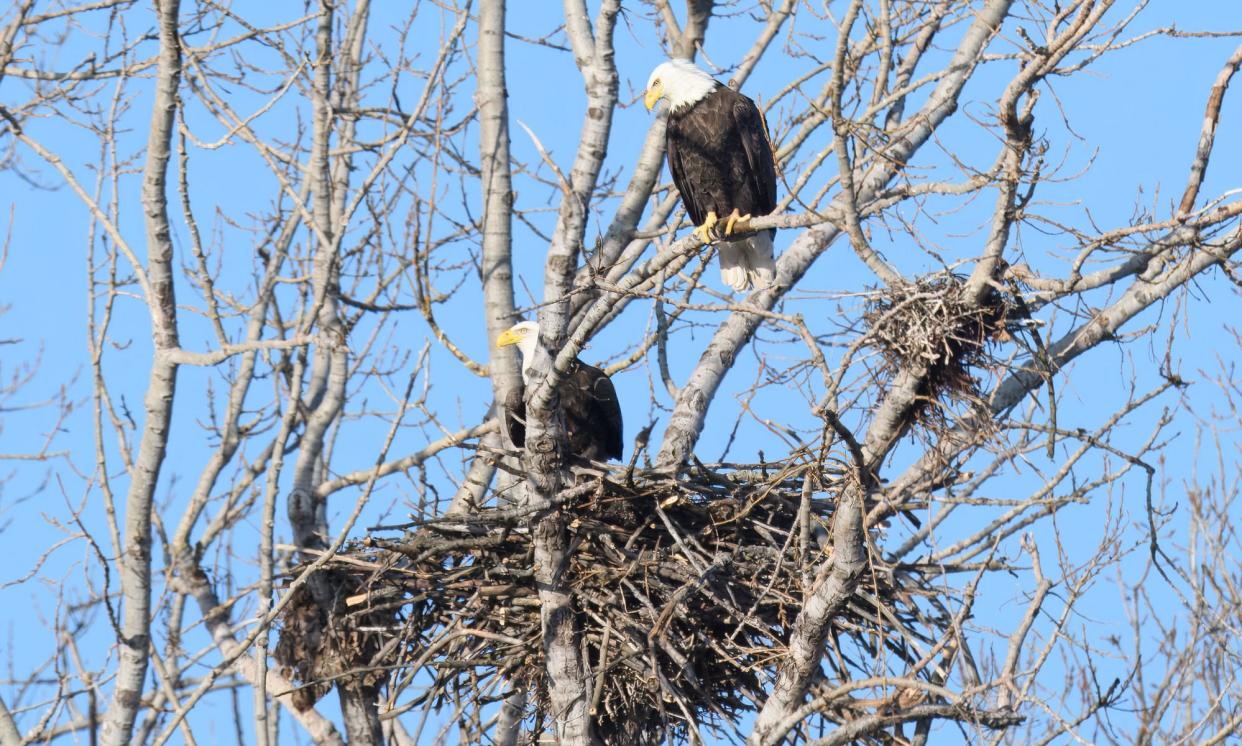Bald eagles seen nesting in Toronto for first time in city’s recorded history

Few things delight residents of Toronto more than unexpected animals in unexpected places.
When a family of foxes took up residence beneath a boardwalk during the coronavirus pandemic, thousands flocked to the beach for a glimpse of the kits. When a beaver waddled throughout the city’s downtown core with a large branch in its mouth, children excitedly cheered on the determined rodent. And even when a raccoon plunged parts of Toronto into darkness, the urban critters were celebrated for their wily, indefatigable character.
Now, there are new residents: a pair of bald eagles are nesting for the first time in the city’s recorded history. Their presence underscores the dramatic return of a bird nearly pushed to extinction and of the improving health of Toronto’s sprawling green spaces and waterways.
Bald eagles, a bird perhaps more associated with the imagery of North America than any other fauna, are a rare ecological success story.
Once common throughout the continent – including in the area that became the city of Toronto – the bird was soon seen as a pest for settlers and farmers. Local authorities encouraged the widespread slaughter of the raptors, promising bounties in exchange for carcasses.
And although policies were later changed and protections were introduced, eagle populations continued to dwindle, especially in urban areas.
A deteriorating habitat was compounded by the presence of DDT, a widely used insecticide. The chemical, popular in the 1940s, worked its way through the food chain and weakened the shells of eagle eggs. By the early 1960s, there were only a few hundred breeding pair left on the continent, said Michael Drescher, an environmental planning and conservation expert at the University of Waterloo. “It was a very sad and very low point for the population.
A ban on both DDT and the hunting of eagles led to the eventual rebound of eagle populations across the continent – widely seen as one of the first major victories of the modern environmental movement.
But Drescher said that eagles are highly adaptable predators and unlike in the case of other threatened species, their two main stressors were easily identified and stopped.
“Other species on the brink of extinction, largely because of habitat loss, are much harder to help,” he said.
In May, the bald eagle was removed from the list of endangered species in Ontario – a move heralded as a success. But Drescher cautioned recent changes to the Endangered Species Act could erode protections for the birds if their prospects changed.
The unlikely success of the bald eagle recovery in many ways mirrors the billion-dollar effort to restore the green spaces and wetlands threading Toronto.
“For decades, we’ve invested heavily in ecological restoration work. And finally, it’s paying off,” said Karen McDonald, who works at the Toronto and Region Conservation Authority’s restoration and infrastructure division. “These eagles are a testament to that: if we didn’t have healthy waters and a healthy food web, I don’t think they’d be here.”
The eagles aren’t the only animals that tell conservation experts that the lands and waters are rejuvenating. Two years ago, an angler caught a 42-inch, 20-lb muskie in the city’s harbour – the first time the predatory fish had been found the area in more than three decades. Northern river otters were once driven from the area. Now, a pair has been spotted traveling from park to park, their five offspring in tow.
“To see these animals returning, it just warms my heart,” said McDonald.
But the arrival of eagles to the city reflects a deepening level of ecological recovery – one that suggests the thrumming heart of Canada’s largest metropolis isn’t just a suitable home for hardened, urban wildlife like squirrels, coyotes and raccoons. Instead, if all goes well, it can host a pair of birds that, despite their fierce looks, are highly sensitive to disturbance.
“I’ll admit that I’m worried. Eagles are really charismatic species and people have this intense desire to connect with nature. That curiosity can sometimes dissolve the willpower to stay away,” said McDonald.
The eagles were first spotted in recent months displaying mating behaviour high above the city, locking talons and tumbling through the air, before releasing close to the ground. In early February, a handful of residents spotted their nest – roughly the size of a queen mattress – among the leafless tree branches and reported it to the TRCA.
Initially, the city’s conservation authority kept the presence of the nest a secret from the public, but McDonald said that strategy became increasingly tenuous as more residents spotted the nest. While it remains “very difficult” to access by foot, it remains near boat and airplane traffic. “We want to give this pair the best chance at making it. We don’t want them to be loved to death by people of Toronto,” said McDonald.
Related: How Toronto’s Don River, once declared dead, is roaring back to life
For those watching the trajectory of Toronto’s seemingly endless sprawl, development and growth, the return of a bird once written off, seems incompatible with a future in which ecosystems are increasingly at risk. But however long they last in the city, the pair also suggest a tangible result to the slow and costly efforts to clean up the polluted rivers, trash-strewn forests and lifeless old industrial sites.
“It’s so easy to get really down about what’s happening in the world these days, with climate change and the non-existent winter we just had. But as someone who works in ecological restoration, I’m a naturally optimistic person. And this eagle pair is just giving me even more optimism,” said McDonald. “If people show them the respect that they deserve, I feel like they’ve got a real fighting chance here.”


